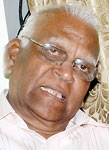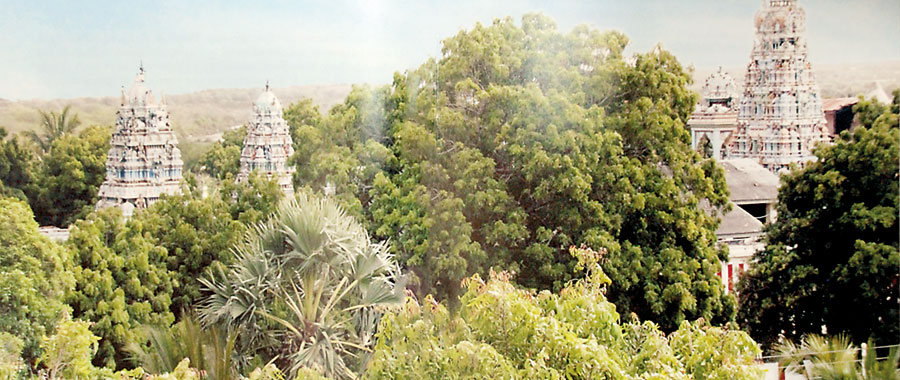Restoring the pearl of Thirukettisvaram: One man’s passion
About seven miles north of Mannar town lies the ancient port city of Manthoddam, or Manthota – enveloped in a breezy haven, where the waves caress the golden sands of ‘Thambapanni’. It was a much sought after city in times gone by for its flourishing trade in pearl and shank fishery, but more importantly, it was home to a pearl above price -the magnificent Thirukettisvaram temple- revered by Hindus worldwide.

Professor S. Pathmanathan Pic by M. D. Nissanka
The temple was destroyed during the invasion by the Portuguese. Manthoddam lost its pearl, but centuries later, Hindus with the aim of bringing it back to its former glory had some of their greatest scholars launch the ‘Temple Restoration Society’.
The story of R. Namasivayam who was amongst the forerunners of this project is told in the book, ‘The life and times of R. Namasivayam’. The book, published under the aegis of his son Rajan Namasivayam, and compiled by Emeritus Professor Sivasubramaniam Pathmanathan speaks great volumes of the struggle to restore Thirukettisvaram.
“Namasivayam was a man of the old world, who was inspired by the education imparted from the home environment. He understood and gained the morals and values of Shaivism,” Prof. Pathmanathan said. “This is a collection of articles in both Tamil and English, on Namasivayam’s quest to restore Thirukettisvaram.”
Namasivayam: The believer
“Namasivayam moved equally well with all sectors of cosmopolitan Colombo, regardless of ethnicity and religion. He was very interested in the fine arts and his wife too being an avid follower of the arts, influenced him a lot. She was the eldest daughter of K. Kanagaratnam, the Deputy Minister of Education and Acting Auditor General in 1949,” said Prof. Pathmanathan.
“An attorney by profession, Namasivayam was a man of unsullied integrity, and he stood up against the authorities whenever procedures were violated. He was a great believer in following his heart’s passion and being undeterred in the face of adversity. The 1983 race-riots was a gruesome experience to Namasivayam, as it was to any other Tamil. His faith in a united Sri Lanka eroding, he took the decision to migrate to England.
The significance of Thirukettisvaram
The Manthoddam port was an important hub of trade between India and Ceylon, as there was a high demand for pearl jewellery in South India. The pearls that were sent from Manthoddam had even been used to decorate the ‘shankavadams’ of Buddhist and Hindu statues in India. The livelihoods of the people grew around Thirukettisvaram, which is indeed one of five recognised ‘Eeswarams’ or places of worship of Siva, which receive the adoration of all Hindus.

Prof. Pathmanathan explains that when the site of Thirukettisvaram was excavated centuries later, archaeologists found the remnants of three significant archaeological objects: Nandhi, the vehicle of Shiva, believed to be placed on a platform in front, a large Shivalingam, usually established in the sanctum, and a unique metallic image of Somaskanda – a composite image with Shiva, Uma and Skanda depicted as a child.
“On stylistic grounds, it should be from the 14th century,” says Prof. Pathmanathan, adding that it goes to show that even after a dip in economy at Manthoddam people still laid much emphasis on adding glory to the temple.
Destruction of Thirukettisvaram by the Portuguese
During the 14th Century, after the Chola period, there was a decline in industry at Mandottham. Prof. Pathmanathan calls it a shift in the demography and interest, with more land based resources such as spices taking over prominence from the marine based resources. However life revolved around the temple up until 1590, when it was destroyed by the Portuguese, who utilised the debris to construct their own edifices. The foundation of the temple was dug out and many artefacts were believed to have been pillaged.
The need for restoration
It was only after 1890, that a policy of tolerance was observed, and people were gradually able to get back to their practices of worship. “The exact location of the destroyed temple was traced, and a plot of land around the site was bought from the government by leading Hindus at that time. A small shrine was set up and Hindu pilgrims visited it. It was in the late 1940’s that the Thirukettisvaram Restoration Society was formed. Shivapada Sundaram was the founder president, and Hindus came forward from various parts of the country to support this project,” says Prof. Pathmanathan.
The first phase saw the completion of the subsidiary stories, and the main temple was to be constructed in the second phase which was spearheaded by R. Namasivayam. “He was able to harness the energy needed to take the project from strength to strength, while architects and sculptors were specially brought down from the School of Architecture and Sculpture in Mahamalepuram, South India, regarded as finest in the whole of India.”

The shrines and metallic images at Thirukettisvaram are works of beauty. The originals were of meticulous precision and the restored ones albeit with certain modifications have lived up to the masterful works of the era gone by, Prof. Pathmanathan said.
Pristine beauty as laid down in the hymns of the 7th and 8th Century
Prof. Pathmanathan believes that the beauty of Thirukettisvaram is not limited to the temple building. The surrounding tranquil parks are home to more than 200 peacocks. He speaks of the truly resplendent atmosphere, amid the playful calls of the peacocks to be similar to the ecological environment described in the hymns of the 7th and 8th century – which describes it as such: “The harbour itself was a safe refuge for many ships from various countries which crowded into it at any one time. The city of Mantota was rich with gold, pearls and precious stones.
In its groves of coconut, mango, arecanut and plantain the density of trees was so great that monkeys sported from branch to branch and flocks of peacocks danced in their cool shade. The scent from the flowers of the well laid gardens oppressed the air and the hum of swarms of bees which kept on flitting from flower to flower, shrub to shrub, competed with the strains of music emanating from the homes of citizens”.
“The journey that R. Namasivayam undertook has been an exemplary one, his life was dedicated to the restoration of the temple and he has been successful,” said Prof. Pathmanathan. He believes that the vision of all those in the restoration committee along with the international supporters has been fulfilled. “The temple will be immensely useful for anyone willing to study Hinduism and its art and architecture as the restored Thirukettisvaram upholds all that is pristine about Hinduism, in a pure form.”
The book will stand as proof of a man who worked tirelessly to restore the pearl of Thirukettisvaram to its former glory. “The life and times of R. Namasivayam” is priced at Rs. 1000 and all proceeds will be channelled to the temple fund.
Follow @timesonlinelk
comments powered by Disqus


